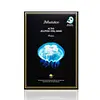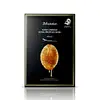What's inside
What's inside
 Key Ingredients
Key Ingredients

 Benefits
Benefits

 Concerns
Concerns

 Ingredients Side-by-side
Ingredients Side-by-side

Water
Skin ConditioningGlycerin
HumectantMethylpropanediol
SolventGlycereth-26
HumectantPEG/PPG-17/6 Copolymer
SolventPhenoxyethanol
PreservativeCarbomer
Emulsion StabilisingTriethanolamine
BufferingPolysorbate 20
EmulsifyingTrehalose
HumectantBetaine
HumectantErythritol
HumectantJellyfish Extract
HumectantEthylhexylglycerin
Skin Conditioning1,2-Hexanediol
Skin ConditioningDisodium EDTA
Xanthan Gum
EmulsifyingAllantoin
Skin ConditioningParfum
MaskingHydroxyethylcellulose
Emulsion StabilisingHydrolyzed Sodium Hyaluronate
Skin ConditioningPotassium Hyaluronate
Skin ConditioningButylene Glycol
HumectantDisodium Phosphate
BufferingPolysorbate 60
EmulsifyingSodium Phosphate
BufferingArtemisia Princeps Leaf Extract
Skin ConditioningCalendula Officinalis Extract
Skin ConditioningHydrolyzed Collagen
EmollientSodium Hyaluronate
HumectantGlucose
HumectantHyaluronic Acid
HumectantHydrolyzed Hyaluronic Acid
HumectantWater, Glycerin, Methylpropanediol, Glycereth-26, PEG/PPG-17/6 Copolymer, Phenoxyethanol, Carbomer, Triethanolamine, Polysorbate 20, Trehalose, Betaine, Erythritol, Jellyfish Extract, Ethylhexylglycerin, 1,2-Hexanediol, Disodium EDTA, Xanthan Gum, Allantoin, Parfum, Hydroxyethylcellulose, Hydrolyzed Sodium Hyaluronate, Potassium Hyaluronate, Butylene Glycol, Disodium Phosphate, Polysorbate 60, Sodium Phosphate, Artemisia Princeps Leaf Extract, Calendula Officinalis Extract, Hydrolyzed Collagen, Sodium Hyaluronate, Glucose, Hyaluronic Acid, Hydrolyzed Hyaluronic Acid
Water
Skin ConditioningGlycerin
HumectantButylene Glycol
HumectantPiper Methysticum Leaf/Root/Stem Extract
Skin ConditioningPropolis Extract
Skin ConditioningRoyal Jelly Extract
Skin ConditioningTheobroma Cacao Seed Extract
AntioxidantMelia Azadirachta Flower Extract
Skin ConditioningCurcuma Longa Root Extract
MaskingOcimum Sanctum Leaf Extract
Skin ConditioningCorallina Officinalis Extract
Skin ConditioningSodium Hyaluronate
HumectantHydrogenated Lecithin
EmulsifyingPanthenol
Skin ConditioningTrehalose
HumectantHydroxyethylcellulose
Emulsion StabilisingCarbomer
Emulsion StabilisingPEG-60 Hydrogenated Castor Oil
EmulsifyingArginine
MaskingAllantoin
Skin ConditioningDisodium EDTA
Glyceryl Acrylate/Acrylic Acid Copolymer
HumectantHoney Extract
HumectantDextrin
AbsorbentHydroxypropyltrimonium Hyaluronate
Hydrolyzed Hyaluronic Acid
HumectantAcetyl Hexapeptide-8
HumectantCopper Tripeptide-1
Skin ConditioningTripeptide-1
Skin ConditioningPalmitoyl Pentapeptide-4
Skin ConditioningHexapeptide-9
Skin ConditioningParfum
Masking1,2-Hexanediol
Skin ConditioningHydroxyacetophenone
AntioxidantCaprylyl Glycol
EmollientWater, Glycerin, Butylene Glycol, Piper Methysticum Leaf/Root/Stem Extract, Propolis Extract, Royal Jelly Extract, Theobroma Cacao Seed Extract, Melia Azadirachta Flower Extract, Curcuma Longa Root Extract, Ocimum Sanctum Leaf Extract, Corallina Officinalis Extract, Sodium Hyaluronate, Hydrogenated Lecithin, Panthenol, Trehalose, Hydroxyethylcellulose, Carbomer, PEG-60 Hydrogenated Castor Oil, Arginine, Allantoin, Disodium EDTA, Glyceryl Acrylate/Acrylic Acid Copolymer, Honey Extract, Dextrin, Hydroxypropyltrimonium Hyaluronate, Hydrolyzed Hyaluronic Acid, Acetyl Hexapeptide-8, Copper Tripeptide-1, Tripeptide-1, Palmitoyl Pentapeptide-4, Hexapeptide-9, Parfum, 1,2-Hexanediol, Hydroxyacetophenone, Caprylyl Glycol
Ingredients Explained
These ingredients are found in both products.
Ingredients higher up in an ingredient list are typically present in a larger amount.
1,2-Hexanediol is a synthetic liquid and another multi-functional powerhouse.
It is a:
- Humectant, drawing moisture into the skin
- Emollient, helping to soften skin
- Solvent, dispersing and stabilizing formulas
- Preservative booster, enhancing the antimicrobial activity of other preservatives
Allantoin is a soothing ingredient known for its protective and moisturizingg properties. Because of this, it is often added to products with strong active ingredients.
Studies show higher concentrations of this ingredient can promote wound healing.
Though it can be derived from the comfrey plant, allantoin is produced synthetically for cosmetic products to ensure purity.
Learn more about AllantoinButylene Glycol (or BG) is used within cosmetic products for a few different reasons:
Overall, Butylene Glycol is a safe and well-rounded ingredient that works well with other ingredients.
Though this ingredient works well with most skin types, some people with sensitive skin may experience a reaction such as allergic rashes, closed comedones, or itchiness.
Learn more about Butylene GlycolCarbomer is a polymer of acrylic acid. Its main role is to create a gel consistency.
A high amount of carbomer can cause pilling or balling up of products. Don't worry, most products contain 1% or less of carbomer.
Disodium EDTA plays a role in making products more stable by aiding other preservatives.
It is a chelating agent, meaning it neutralizes metal ions that may be found in a product.
Disodium EDTA is a salt of edetic acid and is found to be safe in cosmetic ingredients.
Learn more about Disodium EDTAGlycerin is already naturally found in your skin. It helps moisturize and protect your skin.
A study from 2016 found glycerin to be more effective as a humectant than AHAs and hyaluronic acid.
As a humectant, it helps the skin stay hydrated by pulling moisture to your skin. The low molecular weight of glycerin allows it to pull moisture into the deeper layers of your skin.
Hydrated skin improves your skin barrier; Your skin barrier helps protect against irritants and bacteria.
Glycerin has also been found to have antimicrobial and antiviral properties. Due to these properties, glycerin is often used in wound and burn treatments.
In cosmetics, glycerin is usually derived from plants such as soybean or palm. However, it can also be sourced from animals, such as tallow or animal fat.
This ingredient is organic, colorless, odorless, and non-toxic.
Glycerin is the name for this ingredient in American English. British English uses Glycerol/Glycerine.
Learn more about GlycerinHydrolyzed Hyaluronic Acid is a form of hyaluronic acid. It is created by the hydrolysis of hyaluronic acid with a high molecular weight. Once created, Hydrolyzed Hyaluronic Acid has a low molecular weight.
Low molecular weight HA has been shown to hydrate and increase elasticity of the skin. Increasing elasticity is also associated with reduction of wrinkle depth.
One study found topical low molecular weight hyaluronic acid may be considered for the treatment of rosacea in the adult population. However, we always recommend speaking with a professional about your skin concerns.
Hyaluronic acids are a humectant. This means they draw moisture from the air. Hyaluronic acids help moisturize, soothe, and protect the skin.
Read more about other common forms of hyaluronic acid:
Learn more about Hydrolyzed Hyaluronic AcidHydroxyethylcellulose is used to improve the texture of products. It is created from a chemical reaction involving ethylene oxide and alkali-cellulose. Cellulose is a sugar found in plant cell walls and help give plants structure.
This ingredient helps stabilize products by preventing ingredients from separating. It can also help thicken the texture of a product.
This ingredient can also be found in pill medicines to help our bodies digest other ingredients.
Learn more about HydroxyethylcelluloseParfum is a catch-all term for an ingredient or more that is used to give a scent to products.
Also called "fragrance", this ingredient can be a blend of hundreds of chemicals or plant oils. This means every product with "fragrance" or "parfum" in the ingredients list is a different mixture.
For instance, Habanolide is a proprietary trade name for a specific aroma chemical. When used as a fragrance ingredient in cosmetics, most aroma chemicals fall under the broad labeling category of “FRAGRANCE” or “PARFUM” according to EU and US regulations.
The term 'parfum' or 'fragrance' is not regulated in many countries. In many cases, it is up to the brand to define this term.
For instance, many brands choose to label themselves as "fragrance-free" because they are not using synthetic fragrances. However, their products may still contain ingredients such as essential oils that are considered a fragrance by INCI standards.
One example is Calendula flower extract. Calendula is an essential oil that still imparts a scent or 'fragrance'.
Depending on the blend, the ingredients in the mixture can cause allergies and sensitivities on the skin. Some ingredients that are known EU allergens include linalool and citronellol.
Parfum can also be used to mask or cover an unpleasant scent.
The bottom line is: not all fragrances/parfum/ingredients are created equally. If you are worried about fragrances, we recommend taking a closer look at an ingredient. And of course, we always recommend speaking with a professional.
Learn more about ParfumSodium Hyaluronate is hyaluronic acid's salt form. It is commonly derived from the sodium salt of hyaluronic acid.
Like hyaluronic acid, it is great at holding water and acts as a humectant. This makes it a great skin hydrating ingredient.
Sodium Hyaluronate is naturally occurring in our bodies and is mostly found in eye fluid and joints.
These are some other common types of Hyaluronic Acid:
Learn more about Sodium HyaluronateTrehalose is a disaccharide made of two glucose molecules (glucose is sugar!). Trehalose is used to help moisturize skin. It also has antioxidant properties.
As a humectant, trehalose helps draw moisture from the air to your skin. This helps keep your skin hydrated.
Due to its antioxidant properties, trehalose may help with signs of aging. Antioxidants help fight free-radical molecules, unstable molecules that may damage your skin.
In medicine, trehalose and hyaluronic acid are used to help treat dry eyes.
Some animals, plants, and bacteria create trehalose as a source of energy to survive freeze or lack of water.
Learn more about TrehaloseWater. It's the most common cosmetic ingredient of all. You'll usually see it at the top of ingredient lists, meaning that it makes up the largest part of the product.
So why is it so popular? Water most often acts as a solvent - this means that it helps dissolve other ingredients into the formulation.
You'll also recognize water as that liquid we all need to stay alive. If you see this, drink a glass of water. Stay hydrated!
Learn more about Water